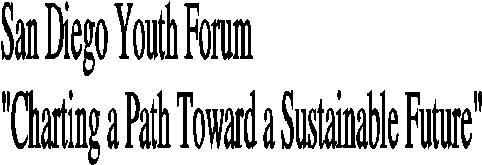

SATURDAY, MARCH 29, 2003
10:30 AM to 3:00 PM
PREPARATORY MATERIAL
Prepare students for a meaningful discussion with community leaders and business representatives by reviewing the list of definitions in advance with the participants. Teachers are also requested to select one student and two alternates for the student panel discussion. Their contact information is to be sent to City staff no later than March 21st.
Voice your priorities about the future of San Diego! Why does that matter? Because, ""We should all be concerned about the future because we will have to spend the rest of our lives there." Charles Kettering. Your decisions about consumption patterns, resource use, and voting have a huge impact. Even if you move out of San Diego, you can make a difference wherever you go. It is up to you to decide whether that difference is positive or negative!
Definitions must be understood before we can successfully engage in a meaningful discussion. Please review the following list and even use these as "searchable words" for internet research.
SUSTAINABILITY
"Do unto future generations as we would want them to do unto us." There are three core components to a sustainable community that must be equally considered- the environment, the economy, and the strength of the social system.
PRINCIPLES OF SUSTAINABILITY
There are many formulations of the principles of sustainability, but nearly all of them incorporate the following basic elements:
Think Long-Term: Sustainability focuses our attention not on the next quarter or the next year, but on the next generation. What kind of community, nation, and world we are passing on to our children and grandchildren?
Recognize Limits: We do not have infinite amounts of land, water, money, or social cohesion. Any of these can be pushed to the breaking point by irresponsible stewardship.
"It's the Economy, Stupid": A sustainable economy not only produces enough for everyone, it promotes innovation and entrepreneurialism. Sustainable industries strive for responsible growth that doesn't harm people or the earth.
Preserve and Restore Nature: Underscoring the economic value of nature, as well as its intrinsic beauty and worth. A sustainable society preserves our ecological heritage, and works to restore those areas previously sacrificed to earlier forms of industrialization.
Be Fair and Equal: Poverty, inequality, and discrimination are inconsistent with sustainability, for both practical and moral reasons. No society can achieve the other principles of sustainability if it does not also strive to achieve this one.
Do the Evolution, Baby: Sustainability is a journey, not a destination. Keep your eyes on the prize, but be prepared to adapt and be flexible, as sustainability looks different at different times and places.
Because sustainability is an ideal, it is impossible to find a perfectly sustainable society or community. But it is possible to determine whether a society is heading in the right direction.
CLIMATE CHANGE: MAN-MADE OR NATURAL?
GREENHOUSE EFFECT: TOO MUCH OF A GOOD THING
Energy from the sun drives the earth's weather and climate, and heats the earth's surface; in turn, the earth radiates energy back into space. Atmospheric greenhouse gases (water vapor, carbon dioxide, methane, and other gases) trap some of the outgoing energy, retaining heat somewhat like the glass panels of a greenhouse.
The Good News. Without this natural "greenhouse effect," temperatures would be much lower than they are now, and life as known today would not be possible. Instead, thanks to greenhouse gases (GHG), the earth's average temperature is a hospitable 60°F. However, problems may arise when the atmospheric concentration of greenhouse gases increases.
The Not-So-Good. Since the beginning of the industrial revolution, atmospheric concentrations of carbon dioxide have increased nearly 30%, methane concentrations have more than doubled, and nitrous oxide concentrations have risen by about 15%. These increases have enhanced the heat-trapping capability of the earth's atmosphere.
[ Source: http://www.epa.gov/globalwarming/climate/index.html ]
The U.S. accounts for 24 % of total global carbon emissions (based on 1997 estimates) while having only 4.6% of the world's total population! The large U.S. GHG contribution is due to its high industrial productivity and, more significantly, to the high level of consumption in residential and transportation sectors.
The maximum population size that a given area can sustain.
In 1996, there were 2.2 hectares (ha) of biologically productive land per person available on the planet. However, the world average footprint was 2.85 ha per person.
PRECAUTIONARY PRINCIPLE
It is best to use a cautious and conservative approach to human interventions in the natural environment because our understanding of the likely consequences is limited and there are threats of serious or irreversible damage to natural systems and processes.
WATER POLLUTION
Results:
ground water seepage
habitat loss, such as wetlands.
fish and seafood contamination
drinking and swimming water contamination
Point sources. Direct discharges to a single point.
Examples:
sewage treatment plants
injection wells
some industrial sources.
Non-point sources. Contamination cannot be traced to a single discharge point.
Examples:
excess fertilizer runoff
herbicides and insecticides from agricultural lands and residential areas
oil, grease, and toxic chemicals from urban runoff and energy production
sediment from improperly managed construction sites, crop and forest lands, and eroding stream banks
AIR POLLUTION
Each year, millions of toxic pollutants are released into the air from both natural and man-made sources:
routine emissions from stationary sources (i.e., factories)
mobile sources (i.e., cars)
accidental releases
forest fires
MATERIAL USE
Resources are extracted via mining or harvesting, used in production, and then consumed as goods or services. Each stage generates waste flows that are recycled or returned as waste to the Earth. Some man-made materials, however, cannot be reused or easily assimilated by nature due to toxicity, non-degradability, or prohibitive costs.
|
|